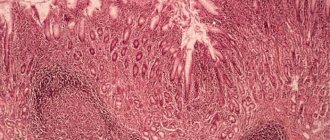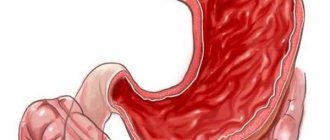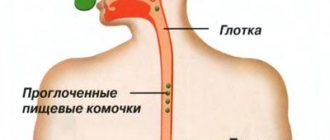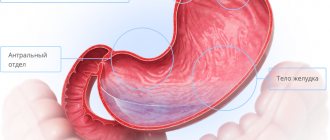Oncological disease of the stomach is a common pathology of the digestive system of the body, which causes a significant percentage of death.
This malignant process occurs in the pathologically altered mucous membrane of the organ, which is preceded by precancerous diseases of the stomach. These diseases of the gastric organ, which are acquired or, in rare cases, congenital in nature, precede the oncological process, but do not always develop into cancer.
According to statistics, gastric cancer most often develops at the age of 40-70 years and is much more common in men than in women. The pathology against which a malignant process develops does not always have severe symptoms and a long course. Therefore, the degeneration of a benign tumor into a cancerous tumor, for the most part, goes unnoticed.
This explains why patients seek help late, resulting in a significantly reduced positive prognosis for life and its quality.
Symptoms and signs of precancerous conditions of the stomach
Diseases of the stomach that precede their cancerous degeneration are the result of qualitative changes in the organ. Any pathology goes through several stages of development with a gradual change in its structure and an increase in negative reactions.
This process can be long lasting and become chronic. But, at a certain stage and under the influence of various factors, the cellular structures of the gastric mucosa begin to change and degenerate into a malignant formation. Precancerous conditions of the stomach are pathologies, which include the following diseases:
- Gastritis with decreased secretory function is most often atrophic gastritis, which is characterized by heaviness in the stomach, flatulence, belching with an unpleasant odor, and intestinal dysfunction in the form of frequent constipation, alternating with diarrhea. Pain syndrome is present, but it is mildly expressed.
- Gastritis with increased secretory function - manifested by frequent heartburn, severe pain in the stomach, especially on an empty stomach or at night, when hydrochloric acid acts aggressively on the empty organ. Vomiting with mucus and bile is possible after eating.
- Stomach ulcer - a pathological process accompanied by “hungry” pain, nausea, vomiting with the presence of mucus and sometimes streaks of blood in the vomit, decreased appetite, and flatulence.
- Polyps are benign formations of a hyperplastic or adenomatous type, capable of malignancy, which are localized on the wall of the stomach. With their small size, clinical symptoms do not appear or manifestations of gastritis occur. With an increase in the volume of pathology, bleeding, cramping abdominal pain, severity and difficulty in evacuating the bolus of food into the duodenum may occur.
As a rule, the reasons for the development of gastric precancer can be very different. In this case, external factors that contribute to the occurrence of this pathology play a major role. These are an unbalanced diet, alcohol abuse, work in hazardous industries, chronic stress, the presence of Helicobacter pylori, long-term use of anti-inflammatory non-steroidal medications ( Aspirin, Diclofenac ).
But the reason for the degeneration of a benign process into a malignant formation has not yet been clarified.
Atrophic changes in the gastric mucosa
Atrophic changes in the mucosa are asymptomatic in the initial stages and are detected after routine medical examinations.
Atrophic changes in the mucosa are asymptomatic in the initial stages and are detected after routine medical examinations
The patient goes to the clinic only when the symptoms are pronounced:
- there is a feeling of heaviness in the stomach, which intensifies after eating;
- appetite decreases;
- an unpleasant taste appears in the mouth;
- occasional nausea;
- severe belching;
- white coating on the tongue;
- upset stool, diarrhea;
- pain in the lower abdomen.
- weight loss;
- poor sleep;
- menstruation disorders;
- anxiety;
- fatigue;
- irritability;
- headache;
- frequent stomatitis.
On palpation, thickening of the stomach wall is felt, bloating, sharp pain, and distinct tension are present. If you have at least one symptom from the list, you should contact a gastroenterologist.
Obligate pathologies
Among all diseases of the stomach that have a tendency to malignancy, obligate precancer is distinguished. These are diseases that necessarily or in most cases degenerate into oncology if treatment is insufficient or not carried out at all. These include:
- A callous gastric ulcer is a formation that is a wound with clearly defined boundaries and a bottom formed by scar tissue. The ulcerative process spreads to the mucous membrane, submucosal, muscular and, in more rare cases, the serous layer of the organ wall. A callous ulcer is most dangerous when it is localized in the area where the esophagus enters the stomach. This location of the pathology increases the risk of degeneration into a malignant process several times. The course of callous ulcers is characterized by severe pain, lack of effect from treatment and frequent exacerbations. As a rule, the process is chronic.
- Adenomatous polyps are benign formations that develop from glandular cells of the gastric mucosa. The method of attachment to the wall of the organ is a pedicle or a wide base. Large polyps, over 2 cm, can cause bleeding or impede the passage of food into the intestines. Pedicled polyps, localized in the pylorus area, can migrate to the duodenum and become strangulated, causing severe paroxysmal cramping pain in the sternum area spreading to the entire abdominal area.
- Gastric polyposis - the growth of multiple adenomatous formations in the pyloric area can cause symptoms of intestinal obstruction.
- Chronic atrophic gastritis is a pathological process in the stomach, accompanied by damage to the cells of the mucous membrane that produce gastric secretions, and its thinning without further recovery. This course of the disease is accompanied by a significant decrease in immunity, leading to the production of antibodies that promote atrophy of glandular cells. If this process spreads over an area of more than 10% of the entire mucous membrane of the organ, the likelihood of malignancy increases several times.
The development of such conditions in the stomach requires early diagnosis, high-quality treatment and mandatory follow-up by a specialist.
Causes
For a long time it was believed that stomach cancer is a primary pathology that develops in previously healthy digestive organs. However, long-term observations have shown that among the patients there are many people with gastrointestinal diseases that are chronic.
Thus, pathologies have been identified in which the risk of developing a malignant tumor increases many times over. Factors that relate to precancerous conditions of the stomach:
- the appearance of ulcerations on the mucous membranes, including damage to the lower submucosal layers;
- the presence of growths - adenomas, polyps, hyperplasia of the mucous layer;
- inflammations that occur chronically, including sluggish ones.
The trigger for tumor development can be mechanical damage. The process can be triggered by injury or surgical treatment.
Advice! There have been cases where the development of cancer was provoked by resection of the digestive organ, carried out due to a pathology not related to the malignant process.
Of course, not all patients with chronic gastrointestinal diseases develop cancer. However, there is a list of diseases that most often lead to malignancy. There are two types of diseases:
- Obligate. These are pathologies that will necessarily degenerate into cancer if they are not cured in the early stages.
- Optional. These pathologies can cause cancer, but not always.
Thus, the main cause of cancer is dysplasia, that is, degeneration of the cells of the epithelial layer of the stomach.
Optional pathologies leading to stomach cancer
Varieties of optional pathologies of the stomach also lead to the development of cancerous tumors, but are less dangerous compared to obligate conditions. Such diseases include:
- Gastric ulcer is a chronic pathological process in the organ, affecting the mucous membrane and the tissues located under it. The process is characterized by a chronic course and clear seasonality. Characterized by typical manifestations of clinical symptoms. Frequent complications during the course of the disease are bleeding, perforation, and malignancy when the ulcer is localized in the pyloric area.
- Ménétrier's disease is a disease whose characteristic feature is thickening of the gastric mucosa, accompanied by changes in the structure of the glands responsible for secretory function. Pathological growths reach gigantic sizes, increasing in thickness to 3 cm or more. On such a hypertrophied mucous membrane, polycystic disease and adenomatosis develop. Sometimes this organ pathology is called adenopapillomatosis. The disease has a chronic course, accompanied by decreased secretory function. The main symptom of the disease is pain that occurs in the epigastric region after eating, accompanied by heaviness in the stomach, sometimes vomiting, and diarrhea. Stomach bleeding may occur.
- Chronic gastritis of the reserved stomach - the disease occurs after resection of an organ in the pyloric area, accompanied by atrophy of certain cells involved in the secretory function of the stomach. In addition, the development of atrophic gastritis of the stump is provoked by the reflux of duodenal contents into the digestive organ. Depending on the degree of development of the process, clinical symptoms may manifest themselves in the form of mild discomfort after eating, accompanied by heaviness in the stomach. But significantly pronounced manifestations of dyspepsia with belching, nausea and vomiting, often with the presence of bile in the contents of the vomit, are also possible. It is in the stump of the stomach that malignant degeneration occurs.
Despite the fact that optional pathologies of an organ are not always subject to changes in their cellular structure with subsequent transition to cancer, vigilance regarding oncology must be mandatory.
Systematic preventive examinations with instrumental examination methods will allow for high-quality therapy of optional pathologies and timely detection of their degeneration.
Symptoms of gastric carcinoma
Early stages of cancer cause the same symptoms as any benign or inflammatory pathology of the gastrointestinal tract, without forcing the person experiencing discomfort to see a doctor.
Often there is not a single sign of illness at all, which is why it is so important to regularly perform endoscopic examination of the gastrointestinal tract during background processes.
The stomach stretches, masking the decrease in its capacity with a growing tumor, and the symptoms do not differ from a banal exacerbation of chronic gastritis; only the progressive loss of body weight with an increase in the volume of the abdomen can be alarming - evidence of carcinomatous contamination of the abdominal cavity with the formation of ascites.
The pain is typical for an ulcer; with stomach cancer, pain occurs when the nerve trunks of the abdominal cavity are sealed into the tumor conglomerate or neighboring organs are involved. More than half of patients notice signs of a common malignant process:
- weight loss,
- increase in belly size,
- vomiting after eating
- the appearance of lymph nodes above the collarbone or palpating a lump in the epigastric region.
Treatment tactics for precancerous conditions
Therapeutic measures can be carried out conservatively or surgically and will depend on the type of pathology developing in the stomach. Treatment tactics are determined by a specialist. A full examination is required, including laboratory diagnostics, objective data and instrumental examination methods.
The leading role in establishing the diagnosis of precancerous diseases of the organ belongs to fibrogastroduodenoscopy (FGDS). It allows you to determine not only visually the type of pathology, but also, taking material for a biopsy during the examination, and confirm the presence of a particular pathology by histological examination. Conservative treatment of precancerous diseases includes:
- therapeutic diet in the diet;
- anti-inflammatory drugs;
- antibiotics according to indications;
- drugs aimed at reducing or stimulating the secretory function of the stomach;
- immunomodulators that increase the body's defenses;
- desensitizing therapy;
- restorative drugs.
The presence of adenomatous polyps, gastric polyposis or callous ulcer requires surgery for these formations. According to the results of FGDS, if the polyp in the stomach is single, its removal is carried out by laparoscopy. But if polyposis or callous ulcer occurs, organ resection is performed followed by drug treatment.
Atrophic changes in the gastric mucosa treatment
Treatment of atrophy of the gastric mucosa will depend on the reasons that contributed to the formation of the pathology:
- in case of bacterial infection, bacteria are destroyed with the help of antibiotics, the microflora is restored;
- acidity and electrolyte balance are restored;
- antispasmodics are used;
- medications that relieve inflammation are prescribed;
- stimulants for the production of hydrochloric acid;
- if the mucous membrane is severely thinned, a diet is prescribed in which food is boiled, stewed or baked, foods that are difficult and take a long time to digest are excluded, and the consumption of fatty foods, fried foods, alcohol and coffee is prohibited.
The diet will have a stepwise appearance - from strict to more relaxed. Meals should be frequent and in small portions until the gastrointestinal tract is completely restored.
Folk remedies should be used carefully; all home treatment methods must be agreed upon with the attending physician. With timely therapy and compliance with all clinical recommendations, the prognosis for recovery is positive.
Forecast and prevention of precancerous diseases and conditions
It is possible to prevent the development of precancerous diseases of the stomach by adhering to the following specific provisions for their prevention:
- proper balanced nutrition in compliance with the daily routine and rest;
- limit the consumption of fatty meats and fish;
- increase the consumption of fresh vegetables and fruits rich in vitamins in the diet;
- increasing the body's defenses;
- cessation of drinking alcohol and smoking;
- take medications with caution and only on the recommendation of a doctor;
- be sure to undergo an annual medical examination;
- after removal of polyps or callous ulcers, mandatory observation by a specialist with an FGDS 2 times a year.
If pathological symptoms of the stomach appear, it is imperative to consult a gastroenterologist with an endoscopic examination of the organ. Early detection of pathological processes in the stomach will allow for high-quality treatment and prevent the degeneration of a benign process into a malignant formation.
The prognosis for future life and ability to work with precancerous diseases of the stomach is positive, but only if the identified pathology is treated in a timely manner.
If therapeutic measures are carried out incompletely or not at all, the prognosis for quality of life will gradually decrease to a negative result as the diseases progress.
Treatment
Treatment of stomach cancer in Israel is carried out by world-class specialists who practice the latest methods of fighting cancer: chemotherapy, immunotherapy and biotherapy using the latest drugs, which are selected individually for each patient in accordance with the results of advanced molecular genetic tests, a unique HIPEC chemotherapy technique that allows achieving better results and avoid side effects, the Da Vinci robotic surgical unit, with the help of which microsurgical operations of increased complexity are performed, and many others. Find out more by filling out the application below.
Common symptoms of atrophy
At home, it is impossible to determine with absolute accuracy which gastritis is beginning - atrophic, antral, toxic or some other. But you can suspect the presence of the disease based on specific signs.
Important! The first stage of atrophic hyperplastic, antral or diffuse gastritis can occur without any symptoms. They are discovered by chance during examination of other organs.
Chronic pathology is characterized by mild symptoms. Symptoms of atrophy are especially noticeable during an exacerbation:
- Digestive problems begin, accompanied by bloating, nausea, heaviness in the stomach immediately after eating;
- salivation increases;
- the patient suffers from constipation or diarrhea;
- moderate pain appears in the area under the left ribs;
- Some experience bleeding gums and vision problems.
Autoimmune atrophic gastritis is accompanied by severe exhaustion and the patient’s inability to eat. The person quickly loses weight, becomes very weak, and cannot eat due to severe pain and nausea.
If the functioning of the secretory glands is completely disrupted, then acute symptoms occur immediately after eating: weakness, false urge to defecate, sweating, burning in the mouth and dry skin, decreased blood pressure. A long course of atrophic gastritis leads to depression, apathy and insomnia.










